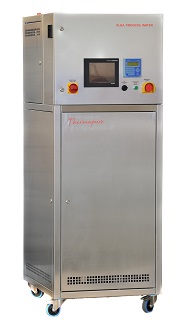Endoscopes and other instruments that are unsuitable for thermal sterilisation at temperatures above 60°C must be chemically disinfected and rinsed in purified water using either Automated Endoscope Reprocessors (AER) or Washer Disinfectors (WD).
As one of the most-reliable and cost-effective water purification technologies, reverse osmosis (RO) systems are the most-common solution to meeting the needs of healthcare facilities
And ensuring the quality of the purified water used by these systems is essential to protect the health of patients and minimise the risk of infection.
The HTM documents and ISO 15883 specify the general performance requirements for the AERs and WDs as well as the quality of water supplied to them.
For final rinse-water, HTM 01-01: Decontamination of surgical instruments and HTM 01-06: Management and decontamination of flexible endoscopes provide strict guidelines on the appearance, acidity (pH), electrical conductivity, hardness and total viable count (TVC) of micro-organisms.
HTM 01-06, also specifies a maximum total organic carbon (TOC) and HTM 01-01 provides maximum chloride, iron, lead, phosphate and silicate levels.
The key advantages of RO systems are that they do not require the use of hazardous or expensive chemicals and as the only ongoing expense is electricity, the cost of operating the system is low
When selecting a water treatment system to deliver this supply of purified water, there are a range of factors that must be considered from system capabilities and the current level of demand, to the quality of the incoming mains water and maintenance processes.
As one of the most-reliable and cost-effective water purification technologies, reverse osmosis (RO) systems are the most-common solution to meeting the needs of healthcare facilities.
RO systems use a semi-permeable membrane to separate and remove 99% or more of the dissolved solids, particles, colloids, organics, bacteria and pyrogens from a water supply.
This membrane is constructed in such a way that when the feed water enters the unit under pressure, the water molecules pass through while the contaminants are captured and discharged.
The key advantages of RO systems are that they do not require the use of hazardous or expensive chemicals and as the only ongoing expense is electricity, the cost of operating the system is low.
However, there are a range of considerations when choosing the specific system.
There are a number of things that can cause the water quality to fall outside of the specified parameters, such as changes in the incoming supply or the accidental introduction of contaminants
Firstly, it is important to look at the number and water usage of AER and WD units that the system will be supplying.
It is essential that the chosen system has the capacity and flexibility to meet these peak water volume demands.
The required up-time is also a key factor.
Where the system will need to run continually, the design will need to reflect this. For example, a duplex RO plant or twin-ring pumps may be specified to achieve close to a 99% up-time.
It is also advisable to consider if the number of units is likely to be increased in the future. And, if so, it is often more cost effective in the long term to invest in a system with additional capacity or the option for simple expansion.
Furthermore, the quality of the incoming mains water supply should also be monitored and tracked, as this will influence the selection and design of the treatment system.
It may highlight the need for pre-treatment measures to be installed, such as where there is hard water or high levels of free chlorine. The chosen treatment system must also have the flexibility to adapt to any changes in the quality of incoming water.
In addition, it is also important to look at how the water quality will be monitored, and the system cleaned and maintained.
While it is important to establish a regime of regular water quality testing in line with HTM guidance, systems with built-in water quality sensors will provide immediate warning of any potential issues.
There are a number of things that can cause the water quality to fall outside of the specified parameters, such as changes in the incoming supply or the accidental introduction of contaminants.

Thermapure is compact and fully heat sanitisable, ensuring the system, as well as the equipment inside, are thoroughly cleaned
Sanitisation of the treatment system itself should also be considered.
Ideally the units should be suitable for thermal sanitisation or even feature automatic disinfection functions. For example, OSIRIS, our fully-integrated, packaged RO water treatment system features automated self-disinfection while the compact Thermapure system is fully heat sanitisable.
It is also essential that a programme of regular planned preventative maintenance is established, and the checks carried out by a qualified engineer in line with the system supplier’s guidance. It may be advisable to engage with a specialist to ensure both system performance and regulatory compliance are maintained.
Disinfection systems are an integral part of any healthcare facility, and the quality of final rinse water used in AERs and WDs must be maintained in line with the HTM guidelines.
Partnering with a water treatment specialist will help ensure that all the requirements are met.
